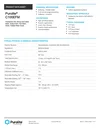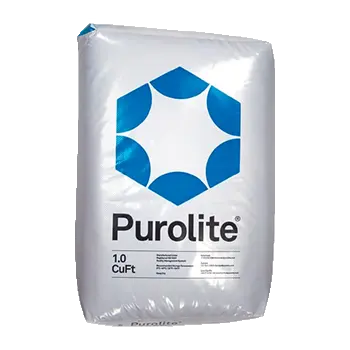Principal Applications:
- Softening - Potable Water
- Softening - Industrial
- Food and deverage processing
Advantages:
- High operating capacity
- Superior regeneration
- Lower rinse volumes
- Superior kinetic performance
- Low extratables
Systems:
- Coflow regenerated systems
Regulatory Approvals:
- Certified by the WQA to NSF/ANSI-61 Standard
Typical Physical & Chemical Characteristics
| Polymer Structure: | Gel polystyrene crosslinked with divinylbenzene |
|---|---|
| Appearance: | Spherical Beads |
| Functional Group: | Sulfonic Acid |
| Ionic Form: | Na+ form |
| Total Capacity (min.): | 1.9 eq/L (41.5 Kgr/ft3) (Na+ form) |
| Moisture Retention: | 45 - 50 % (Na+ form) |
| Particle Size Range: | 210 - 600 μm |
| < 210 μm (max.) : | 1% |
| Uniformity Coefficient (max.): | 1.6 |
| Reversible Swelling, Na+ → H+ (max.) | 10% |
| Reversible Swelling, Ca2+ → Na+ (max.) | 8% |
| Specific Gravity: | 1.27 |
| Shipping Weight (approx.): | 790 - 825 g/L (49.4 - 51.6 lb/ft3) |
| Temperature Limit: | 120 °C (248.0 °F) |
| Polymer Structure: | Gel polystyrene crosslinked with divinylbenzene |
|---|---|
| Appearance: | Spherical Beads |
| Functional Group: | Sulfonic Acid |
| Ionic Form: | Na+ form |
| Total Capacity (min.): | 1.9 eq/L (41.5 Kgr/ft3) (Na+ form) |
| Moisture Retention: | 45 - 50 % (Na+ form) |
| Particle Size Range: | 210 - 600 μm |
| < 210 μm (max.) : | 1% |
| Uniformity Coefficient (max.): | 1.6 |
| Reversible Swelling, Na+ → H+ (max.) | 10% |
| Reversible Swelling, Ca2+ → Na+ (max.) | 8% |
| Specific Gravity: | 1.27 |
| Shipping Weight (approx.): | 790 - 825 g/L (49.4 - 51.6 lb/ft3) |
| Temperature Limit: | 120 °C (248.0 °F) |
Downloads

